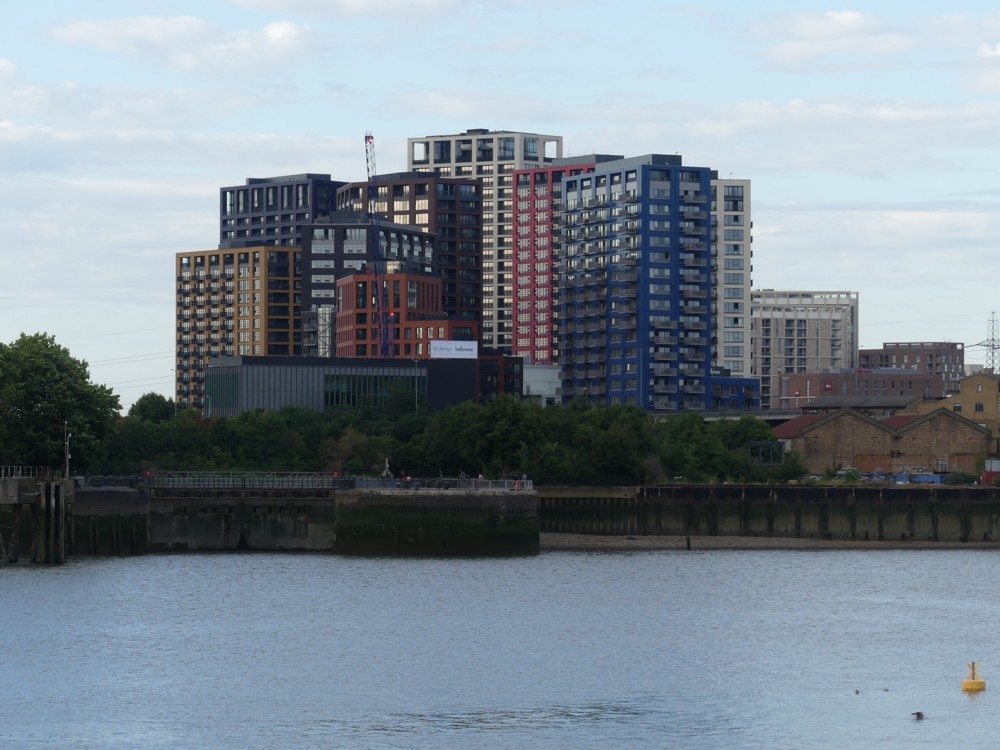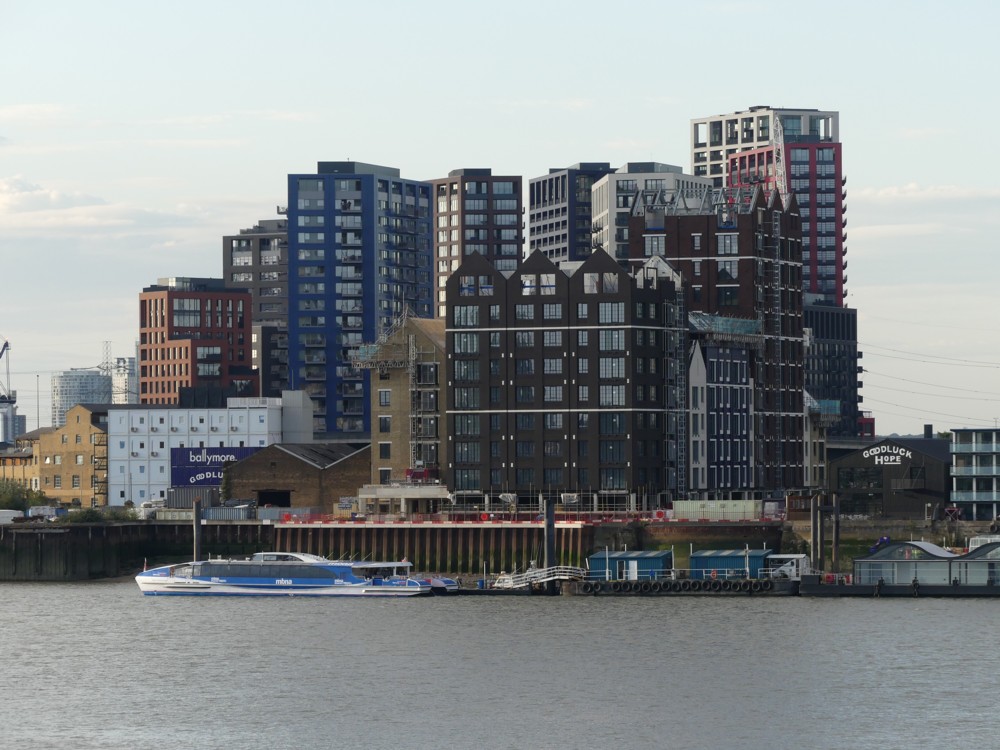Last year, at the end of July, I went on an expedition out East, to the Dome and related attractions and excitements, and this evening I was looking through all the photos from that expedition, some of which I’ve shown here already. And, I found myself rather liking these two photos, both of the London City Island tower cluster, on the other side of the River from where I was:
This cluster is just the the other side of the River Lea (the final meanderings of which create the island in question), from Canning Town Station. The one on the right photoed about forty minutes of wandering downstream after the the one on the left.
In the second and smaller of the two images in this 2015 posting from the Old Blog, now here, you can see an aerial fake-photo of how they then merely reckoned it would look. By now, it’ll be finished and occupied.
London is fast become a city not so much of towers, but of tower clusters. The Big Things of the City have now coalesced into one big lump. Docklands ditto. Battersea is heading that way. Soon there’ll be another cluster, upstream from Tate Modern. In the years to come, it may join up with the nearby cluster around the old Shell Building at Waterloo, next to the Wheel.
The light wasn’t that good when I photoed the above photos, but you can see what I want you to see. What I like about this London City Island cluster is that, well, I like it. Its basic job is to fit lots of people into a small area, without excessive cost or bother in the form of “architecture” – unfunctional curves and weird shapes of various sorts, or strange structural illogicalities. This isn’t Starchitecture. It’s a collection of Machines for Living In. But, because the design of all the blocks has been made, as it were, to “rhyme”, the effect is rather pleasing, unlike the usual London cluster mess. Don’t misunderstand me, I don’t mind cluster messes. They’re very London. But I’m glad that one of these clusters is a bit more aesthetically coordinated, because it makes a change. The bright colours of each of the towers adds to the air of a group of buildings all designed at the same time. In London, this seldom seems to happen.
But, if you come back at me and say it’s just ugly lumps, in the usual London way, well, so be it, I won’t argue. Like I say, basically these are Machines for Living In. What they do for London is accommodate more people in comfort. How it all looks is somewhat beside that point.
But, I like the way it looks.



Brian, have you encountered the expression “Fast casual architecture”? The analogy is with the expression “fast casual restaurant”. A fast casual restaurant is something like Pizza Express or Carluccio’s. Nicer than a McDonald’s, and with the features of a full service restaurant such as waiter service, alcohol service etc, nicer decor, perhaps a little variation from location to location, but still ultimately designed to a formula and ultimately the same as every other restaurant of that chain. Ideally good quality but of a sameness. This development is fast casual architecture par excellence I think.
I quite like the way London City island is on a finger of land almost completely surrounded by the River Lea. Canning Town tube station is on the other side of the Lea, and there is a little footbridge making to tube station accessible from the housing. Cross the bridge and turn right and you head towards the Royal Docks and you remain in fast casual architecture land for some time. Turn left and down Canning Town high street and there is a very dramatic shift to being in traditional East London. There’s lots of these dramatic shifts when walking in and out of new developments along the river once you are east of the City.
I agree Michael, though of course unlike the restaurant examples, fast architecture has been around for a long time. 30’s housing, Victorian and Edwardian terraces, The White stucco buildings of west London, Georgian terraces, most of central Paris. Each the same basic idea repeated many times with minor variation. In fact I would say modern technology enables the latest fast architecture to have a bit more variation on the theme than the other older examples. The difference I think is residential v offices. Commercial buildings are more individual and often intended to make a statement on behalf of the owner or tenant. Housing is more of a mass production. The restaurants you describe are where through growing wealth the masses can afford something that used to be the preserve of the rich and so we see not only unique destination restaurants but also a commodified mass produced offering. This is a good thing in my view. Commodification has been the process by which many people can afford something they used not to be able to. However further technological progress in automation, computer visualisation and eventually in AI will allow increasing “mass customisation” where we can have more variety at affordable prices. Its no longer any colour you like as long as its black. And I think you see that in the fast architecture you mention around the eastern Thames – on the Greenwich peninsula, on the Royal Docks etc. There is much more variation on the basic idea than there was say during 60’s tower block building. Brian you should go and photo City Island again from the river by the dome. There is a new development going up in front of it and a big one on the other side of the River Lee. It no longer stands out the way it did when you last photoed it.
Oh I’ve just realised your second photo already has the development in front of it. You’ve been more recently than I realised.
Thanks for these comments, obviously. Much appreciated.
I think one reason I particularly like London City Island is that, because it is surrounded by water, there is an abrupt cut-off from quite high buildings to no buildings at all, at any rate from certain angles (as Alastair notes). Sort of like Manhattan on a tiny scale. This gives it a very individual cluster shape. More like a haystack or a cake than the usual cabbage patch going to seed effect, where there is one or a very few very tall Things in the middle and less tall as you move outwards from the centre of the cluster, with no clear cut-off point. The City of London Big Thing cluster is more like that.
Strongly agreed about the benefits to the less well-off of commodification. I recall picking out a JP Floru quote for Samizdata, about what a boon it was when they started making shoes in a range of standard sizes rather than only individually fitted. Prices plunged, and a whole generation of middling folks suddenly got to wear nice shoes for the first time, that were comfortable.
And following on from what Alastair said about this sort of architecture not being new to London, I should have said, near to the end of the original posting: “This seldom seems to happen in London, now.” Because of course it did happen in times gone by, as Alastair noted.
Alastair, for most of those cases you give above, the designs were uniform but local. There was a Paris version. There was a white stocco west London looks, there was a Georian terrace look. To some extent these were duplicated where there were political connects – other Georgian terraces in places under British rule, for instance – but although there was local uniformity, there was a lot of international difference.
What we have now I think is more global uniformity. A fast casual development (usually beside the water in some regenerated area) in London looks very similar to one in Shanghai which looks similar to one in Vancouver which looks similar to one in Malaysia which looks similar to one in Azerbaijan. There is more individual variation between the dwellings, but there are more global similarities between the developments.
I agree that all this is, overall, good.